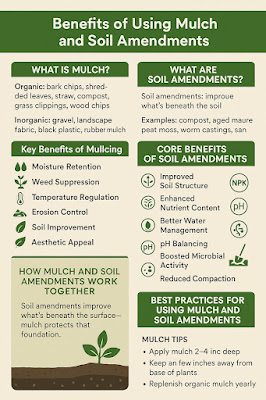Unlocking the power of mulch and soil amendments: A gardener’s guide to healthier soil and thriving plants
Healthy soil is the cornerstone of a successful garden, and two of the most powerful tools for improving soil health are mulch and soil amendments. Whether you're cultivating a vegetable patch, a flower bed, or a lush landscape, understanding how to use these elements effectively can drastically enhance plant performance, water retention, and soil vitality.
In this blog post, we’ll explore the full range of benefits that mulch and soil amendments offer and how you can incorporate them into your garden for long-lasting success.
What Is Mulch?
Mulch refers to any material—organic or inorganic—applied to the surface of the soil. Common types include:
- Organic: bark chips, shredded leaves, straw, compost, grass clippings, wood chips
- Inorganic: gravel, landscape fabric, black plastic, rubber mulch
Key Benefits of Mulching
- Moisture Retention: Reduces evaporation and keeps roots hydrated longer.
- Weed Suppression: Blocks light and prevents weed germination.
- Temperature Regulation: Insulates soil from temperature extremes.
- Erosion Control: Prevents topsoil from being washed away.
- Soil Improvement: Organic mulch enriches soil as it breaks down.
- Aesthetic Appeal: Creates a clean, finished look in garden beds.





